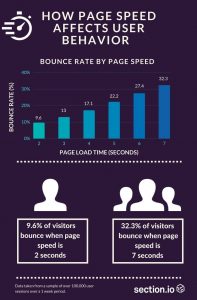Website Design Checklist for Small Business Owners . Part III
Is your site loading slowly? It could kill your site’s popularity and business potential. Besides speed, there are a few other things you may like to test.
By the way, this is Part III of the article. Part I is about the scope of your website getting content ready and Part II is about formatting content. You can find them here Website Design Checklist .
Also, I am assuming that you are a business owner. You are trying to get some idea and also test your website to see if it’s OK. You are not an experienced designer.
Part 3 – SEO & Testing
I have avoided using the acronym SEO in the first part of the article as this is a huge topic and summarizing is difficult.
So what’s SEO? Bing, Yahoo, Google bots (software robots), etc visit websites from time to time and build up an index of web pages. When someone searches for a word let’s say “hand sanitizer” Google shows the best and most popular pages one after another, as per their rank. Now, what’s best? What is the most popular? How does Google rank them? SEO Experts say there may be 200 factors that Google looks at. Google gives us hints and also guidelines about building a site. However, they won’t tell you or me the exact formulas or algorithms they use to evaluate a site, so that we cannot game the system. Also, these formulas keep improving all the time.
An important SEO factor is do other trustworthy websites mention your website? Is it a nice popular article where your website is mentioned? Or is it just a standalone link nobody clicks? This is a critical factor in SEO. Yet, we will not discuss at this point as it is an external factor or Offsite SEO, and hence outside the scope of this article. We will look at factors that are to be considered initially at the time of building the website, which you may find difficult to change later on.
We will discuss a few points related to the Onsite SEO Factors below.
# Accessibility – Keep the door open
Is your theme Google Bot friendly? Some themes with badly written code can block bots. So search engines won’t be able to crawl and index your pages. Therefore, you need to set up Google Search Console. Here the overview reports will tell you if there are errors. All errors are not serious though. The error fixing will have to be done by your developer of course. It’s not at all difficult to set up the search console.
You may also run the following tools and shows errors to your designer if any.
- Structured Data Testing Tool from Google
- Robots Testing Tool from Google
All test links are available in the link mentioned here
# Domain & URL – Less Known Aspects
How old is your domain? Older domains rank higher. New domains may not rank at all for a few weeks.
But you can’t buy an old domain, can you? Yes, you can, if somebody is not renewing a domain they purchased a year back or so. You may be able to find a domain name that suits you in an auction. Many people buy and sell expired domains. Just search “buy expired domain”. Be warned that many of these domains are overvalued. Some domains show a lot of traffic or visitors, and also backlinks. The traffic is often fake traffic. Yes, you can create fake traffic for free. Backlinks of expired domains are mostly useless unless there is traffic coming from them.
Is your domain name a Keyword? Let’s imagine you have a bakery in New York. And your domain is called “bakeryinnewyork.me”. Since people invariably search for “bakery in new york”, this is a keyword and can help you rank better. On the other hand, Google will see it as spam if you have little text or content and a lot of outbound links in such a domain.
URL – Let’s suppose your website is called “mybakery.us” instead. Here your products page can be called “mybakery.us/bakery-new-york”. This also helps, provided text on this page talks about “bakery products you offer in New York”. The page title and image names also should match the subject matter of the page. Watch out – renaming an existing old URL means you are creating a new page and suddenly your old page has gone missing. You will lose ranking at least for some time to come.
So, these are factors you need to consider at the very beginning.
# Content Optimization – Content is King
Can Google understand your web page? Subject matter should be included in the Page Title, Image Alternate Text and in the content to make it easier for search engines to understand. Using AI-based technologies like “neural matching” Google tries to understand the subject matter. Now, if you fill up your content with keywords it will be seen as keyword spamming. Some SEO experts recommend key words at .5 percent of the content. So you need to use synonyms and “related words”. You can key in the keyword at Ubersuggest and LSIGgraph to find out related words. They actually use the term “Latent Syntax Indexing” when talking about related words. Phew! As for me, I find it difficult to pronounce and so I generally avoid it.
What user intent are you targeting? A user may want to “buy”, “see information” or just “navigate” when he is typing a keyword. Obviously your content should match the intent.
Do you have 2000 words in the content? Many of my customers tell me – people don’t read much these days and therefore we should keep it short. However many SEO experiments show that pages with 2000 to 2500 words rank better. Also, they say “Content is King”. So if you hate writing you may get someone to write for you.
# Page Speed – How to improve
This point is dependent on the theme or code, content (pictures) and server.
How does a Theme affect Page Speed? A few years back some of the themes we were using were slow. Updates over the years have made them among the fastest. Is your designer going to use a theme? What theme? If you buy a popular theme and even if it is not fast enough today there is a good chance that they will improve over time. Where free themes are concerned there is no commitment from designers to provide an update. If it’s a business site you are building you might avoid free themes.
How long does it take to load? I’ll suggest webpagetest.org. Here, you need to choose your country or nearest server location first. Now the Google Crawl Bot measures how fast your page loads in your country. This site will give a good approximate number. What if your target market consists of many places across the globe? You’ll need a CDN or Content Delivery Network.
What’s a CDN? This is a network of servers. They have servers scattered across the world. Be warned though, CDNs have incompatibility issues with many themes. I had difficulty with CDNs myself.
Now, does your site load slowly as it has a lot of content on the Home Page which you can’t do away with? We will talk about other landing pages a little later. First, let’s talk about your server.
Where is your server? The location of a hosting provider’s server has a role to play in SEO. If the Server is in Alaska, USA, and your home country is somewhere in South East Asia, there could be a delay of 300 milliseconds in Time to First Byte. Now TFB is the time it to get the first packet of data from your server after you enter the website name in your browser and hit the enter button. Ideally, Google wants it to be below 200 ms. I guess it’s OK if you cross this number by 10-20 percent. But 300 ms is the way off the mark. TFB also depends on how fast your servers CPU is, cache implementation and what’s at the beginning of your page.
How do you know Time to First Byte before purchasing the hosting package? Just ask them.
Hosting companies often have servers located in different parts of the world. Check them out. The plan or package also matters especially if you foresee have high traffic.
Additional Landing Page – Normally your Home page is the main landing page. Now, do you have a number of things, that you invariably need to feature on the home page, making it bulky? In such a case you may like to build different landing pages for different product lines and inquiries. You can have a lightweight page for capturing leads and connect this page to Facebook, Google Ads, etc This page could have a better rank in Google Search.
What’s your Google PageSpeed Insight Score? Google PageSpeed Insight, shows loading speed and rendering. Where desktop speed is concerned, too many pictures and bad code will give you a score below 90. So, it is like being in a situation where you are running to beat competitor’s websites in Google Search, with one of your legs tied to an iron ball.
Ideally, we need to keep the size of the web page below 1.5 Mb and use a cache that compresses and optimizes the loading. Google recommends that you load a website within two seconds. Where desktop is concerned this is achievable even if your page has two to three full-width pictures and animations etc. However, loading a page on mobile in two seconds is difficult.
Can’t we have different pages for mobile phones? Yes, you can, but optimization is easily achieved by hiding large pictures on your page from loading on mobile phones. You can have a shorter write-up for mobile phones which you may hide in Desktop.
You’ll find the link for testing PageSpeed in the URL mentioned at top of the article.
# Mobile Friendly – Just Test it out
Is your page mobile phone friendly? If your theme is responsive then that’s all. A theme should resize and adjust the layout of contents to fit the device whether it’s a laptop or, mobile or tablet. That’s what responsive is. What I know is that all themes are responsive these days. Anyway, you should check out and see how it looks on a mobile.
# User Experience – Give your best shot
Are users finding what they are looking for? If they are not, they will not click any other link and leave. Not clicking any other link and leaving is called “bouncing off”. How much time they spend on the site is also important.
How do you know if they are bouncing off? You need to set up Google analytics. It will give you what they call the “bounce rate”. A low number means a small number of people have bounced off. What’s the optimum number” This is tricky as it varies from site to site or rather industry to industry. Let’s suppose there is a weather site that detects the city you are viewing from and shows you the weather forecast for your city immediately. You do not need to view anything more and you close the site. So the bounce rate will be 90% plus.
To make things clear The Search Console is about “what the Google Bot was able to find when it searched your site on so and so date”. Google Analytics is about “when and from where visitors are coming from and what they are doing in your website”. You also get some demographic information. However, Google Analytics is overwhelming. There are too many things. If your developer can display a number of unique visitors per month, sites they are coming from (like Facebook, etc) and direct visitors in your admin panel, it’s something great to start with.
How to reduce bounce rate? You have to put yourself in the customer’s shoes when writing or organizing content. The normal tendency is to put a broad corporate profile and not display the products that most customers are looking for. What you can do is put bits information on what customers may be looking for with a View More Button. So, customers need to click. Videos, testimonials, Pictures also captivate customers. So now you want to fill up the site with pics? Look below.
What happens when your website loads slowly? People bounce off. The following is an infographic from a company called Section.

Hmm. What do you think buddy? You can see now why Google is saying” load you page in 2 seconds”.
# Social Signals – What you can easily do
Having a page on Facebook or LinkedIn with your website URL in it doesn’t improve your site’s ranking directly. At least that’s what Google declares. Nevertheless, they bring in traffic and this improves ranking. Also, cognitiveSEO has shown us via an experiment that there is a relation between social shares and rank. Therefore, sharing website content in social media has SEO value. So you need sharing buttons on all pages. We will discuss a little more about sharing in Part IV of this article.
To keep this article short and easier to understand we will avoid factors like the one mentioned below, which you can look at during a revision and improvement session.
# Technical SEO – Discuss with your designer
Your designer needs to add meta tags and apply tags like h1, h2 tags to headings. Importance wise this is probably next to accessibility mentioned at the top.


